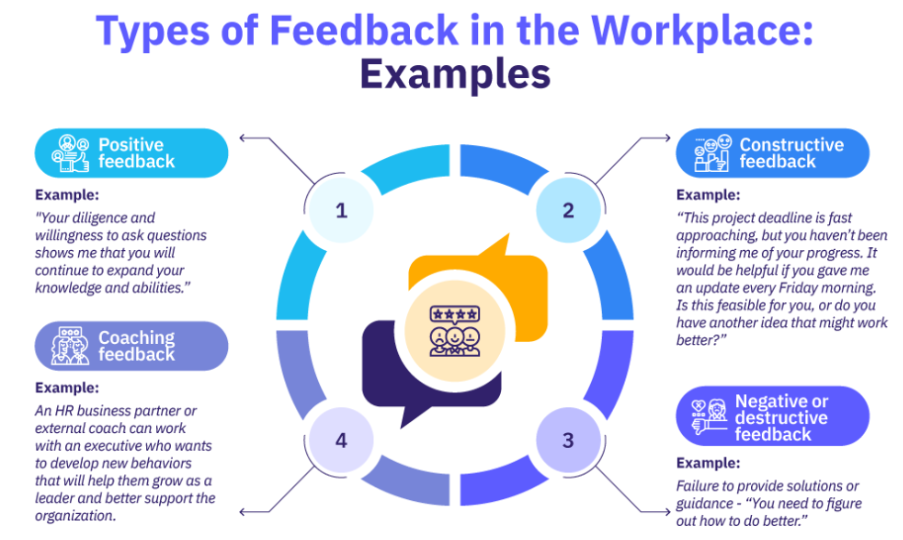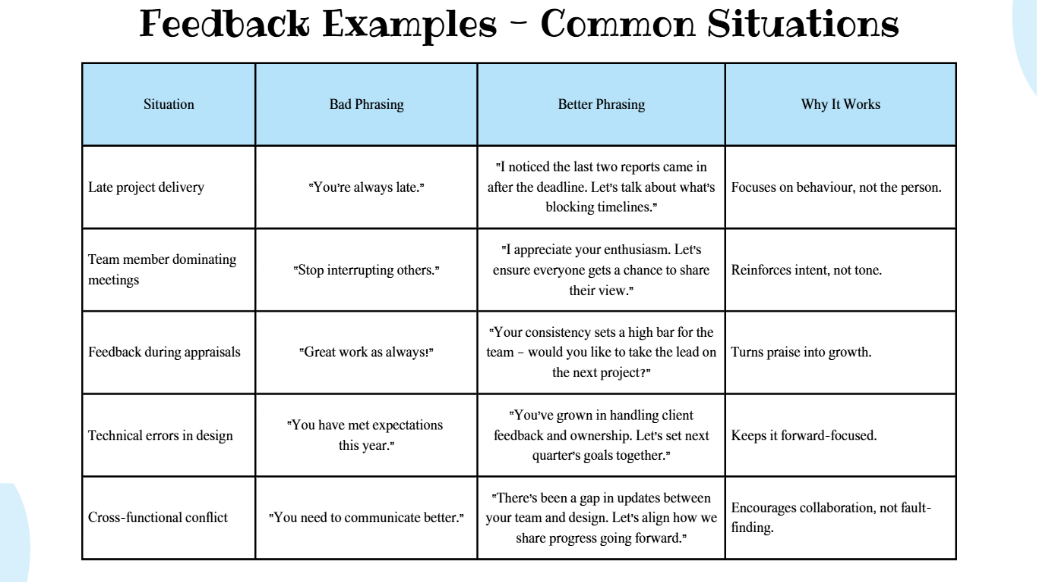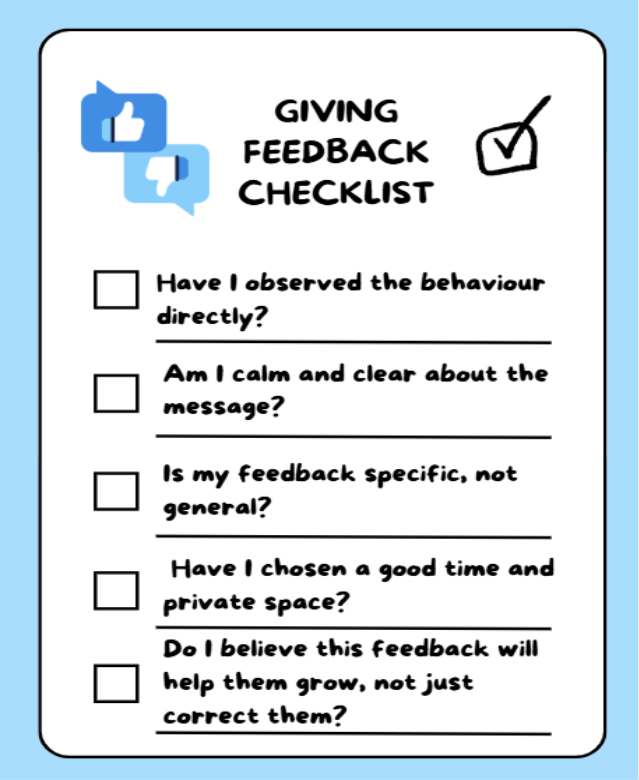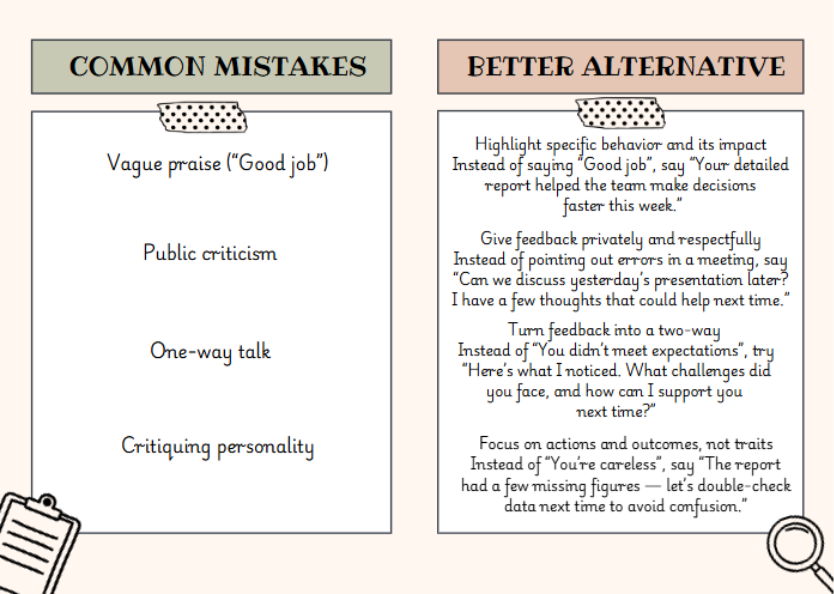Workplace Communication
Giving Feedback That Builds Confidence and Performance: Indian Workplace Edition

.png)
Written by
Aarohi Parakh,
Psychologist and Content Writer

Reviewed by
Sanjana Sivaram,
Psychologist and Clinical Content Head

Introduction
Visualise this! You are a mid-level marketing manager in a leading FMCG firm in Gurugram. One of your team members, Piya has just finished an ad campaign that has clearly missed the customer brief. You know she is earnest and capable, but you hesitate. What if she takes it personally? If you remain silent, you risk this happening again and impacting the firm's reputation. In many Indian offices, that conversation rarely happens— feedback is postponed to annual reviews, filtered down, or left ambiguous.
Yet, feedback is what bridges the gap between intention and impact. It is one of the most productive tools for driving workplace improvement. And the stakes are high: 65% of employees say they would be more engaged if they received more feedback, but 40% report rarely getting meaningful feedback. In the Indian context, where hierarchy, indirect communication, and “saving face” are deeply embedded, giving feedback feels especially tricky.
So, it’s no surprise that many managers quietly wonder: “If I say something, will I demotivate them?” But here’s the promise: this guide will show you how to give feedback in a way that is constructive and professional— one that respects cultural sensitivities and empowers people. From frameworks to real-world examples, you’ll get actionable tools for giving effective feedback.
Why Effective Feedback Matters (Especially in Indian Teams)
Let’s get back to Piya’s example. The missed brief wasn’t just a creative slip-up — it was a communication gap. As a manager, if you quietly “fix it”, she may never realise what went wrong. But a clear, timely conversation about what worked and what went wrong could turn an error into a learning opportunity. That’s the essence of effective feedback — it fuels growth, confidence, and trust.
- It drives performance, confidence, and accountability: Constructive feedback highlights a specific behaviour or outcome that needs to change and offers actionable suggestions to support growth. In Piya’s case, feedback from her manager would help her understand exactly how to align her next campaign with the client’s brief—and feel more confident doing so.
- It builds psychological safety: In Indian workplaces, where hierarchy can often silence voices, a safe environment where people can speak up can be transformational. When managers normalise two-way conversations in which employees can also share what they need, it creates a culture of trust. Team members like Piya won’t fear feedback; they’ll invite it.
- It prevents passive disengagement: One of the biggest silent killers of productivity is quiet disengagement of employees. While they may agree on most things to avoid conflict, they mentally switch off easily. By giving regular feedback, minor concerns can be nipped in the bud. Piya, for instance, might be unaware that her creative choices didn’t land well because of unclear expectations. Her manager’s guidance can fuel her motivation and prevent frustration from building.
- It enables career conversations and retention: Feedback is not always about fixing gaps, but also about recognising growth. For Piya, constructive feedback could evolve into a larger conversation about her future career choices in brand strategy or consumer insight — helping her see feedback as a pathway, not a negative response.
The Different Types of Feedback (And When to Use Them)
Every kind of feedback serves a different purpose. Great managers know when to encourage, when to coach, and when to correct. Let’s break them down:
- Positive (Appreciative) Feedback: It acknowledges and reinforces behaviour that produces desired results. It’s a way to encourage a person to continue applying their strengths while they carry out their responsibilities. This method is used to recognise effort, celebrate wins, and boost morale. Appreciation doesn’t have to wait for appraisals. A quick “well done” message or public recognition during team meetings boosts morale.
- Constructive (Developmental) Feedback: It uses observations and advice to focus on improvement areas that will help someone grow and move forward. It’s focused on behaviour, not personality. The tone is solution-oriented, not critical.
- Coaching or Growth-Oriented Feedback: It’s a hands-on approach where the manager sees potential in the employee and provides guidance on strategies to excel in their role or plan their career progression. This kind of feedback nurtures leadership and autonomy.
- Corrective or Negative Feedback: While it’s common to confuse this with constructive feedback, they are, in fact, opposites. Negative feedback is destructive – focusing only on someone’s flaws, without offering support. Constructive feedback, on the other hand, aims to help someone learn from their mistakes. Such feedback should be avoided in public, especially in Indian teams, where it can feel like humiliation.

When and Where to Give Feedback
While how to give feedback is important, when and where to give feedback is equally important.
Timing Matters
Sharing feedback while the context is still fresh, ideally closer to the event, can be the most impactful. The timing of the feedback would also largely depend on the learning goals — immediate feedback may help if employees are learning new skills. Still, slightly delayed feedback may be more helpful when applying the learnt skills. In any case, feedback should be avoided during the heat of the moment, as emotions can distort the message.
Choose the Right Setting
In Indian workplaces, privacy becomes crucial. Public correction can be misinterpreted as an act of embarrassment.
- Use one-on-one conversations to convey any sensitive issues. Public settings should be used for praise and recognition, not for any criticism.
- For hybrid teams, giving feedback remotely using quick online calls instead of long emails would be beneficial. There is a higher chance the tone will get lost in text.
Regular Check-ins Work Best
Sticking to annual performance reviews to provide feedback may no longer be the most effective tool for managers. Employees are 3.6 times more likely to strongly agree that they are motivated to do outstanding work when their manager provides daily (vs. annual) feedback. Short, frequent conversations (monthly 1:1) normalise feedback and would not seem threatening.
Proven Feedback Frameworks You Can Use
Having a structured framework for providing feedback can help managers turn vague comments into clear, actionable guidance for employees. These globally trusted feedback models work well when adapted to Indian teams.
- SBI (Situation–Behaviour–Impact) Model
Developed by the Centre for Creative Leadership, it is one of the most widely used frameworks because of its clarity and simplicity. It breaks feedback into three clear parts: situation, behaviour, and impact.
Example: “In yesterday’s client meeting (Situation), you interrupted Meera twice while she was explaining her idea (Behaviour). It made it seem like her input wasn’t valued (Impact).”
This feedback model reduces defensiveness by focusing on facts.
- STAR (Situation–Task–Action–Result) Model
The STAR model is commonly used in interviews but is equally powerful in feedback conversations. It extends the SBI structure by adding the task element, which links a person’s responsibilities to their actions and outcomes. This makes it especially useful when you want employees to understand the bigger picture behind their efforts.
Example: “In last week’s client onboarding session (situation), you were responsible for explaining our compliance process (task). You created a step-by-step visual guide and walked the client through it patiently (action), which built their confidence and reduced follow-up queries by half (result). Great work.”
- Sandwich Method
The Feedback Sandwich is one of the most familiar frameworks, especially in workplaces that value maintaining morale during feedback. It “sandwiches” constructive criticism between two layers of positive feedback. However, its limitation is that employees may see the structure as predictable, leading to a loss of trust. Sometimes, it can also get confusing, and the feedback can get lost. This method should be used with caution.
Example: “Your project documentation was very thorough and well-formatted (positive). However, some technical terms weren’t clearly explained, which confused the new hires (criticism). I know your writing skills are strong, and I’m confident your next version will be even more user-friendly (positive).”
- Feed-Forward Model
Unlike most feedback frameworks that look backwards, the Feed-Forward model focuses exclusively on the future. The idea is simple: instead of analysing past mistakes, employees should be guided on what they can do differently next time. This approach minimises defensiveness and creates a forward-looking mindset.
Example: Instead of saying, “Your last client pitch lacked clarity,” a manager could say:
“In your next pitch, try using three slides to summarise the key value points. This will help the client focus and improve understanding.”
- Ask-Listen-Coach Loop
In Indian teams, where direct confrontation can often be uncomfortable, asking questions to invite reflections can help managers break the ice with employees. It helps create a two-way dialogue, rather than a lecture.
Example: “How did that presentation feel to you? “What would you do differently next time?”
The manager can provide their insights and guidance after listening to the employees, which can serve as a feedback loop.
How to Handle Difficult or Defensive Reactions
Receiving feedback may not be easy for employees, and sometimes it may evoke unexpected reactions. Remaining calm at such times is the key for managers. In Indian workplaces, common responses can be in the form of:
- “Yes, Sir/Ma’am” compliance: polite agreement without any genuine commitment to incorporate the feedback at work.
- Silence Avoidance: may seem like a sign of respect, but often means discomfort.
- Resistance masked as submission: agreeing verbally but still doing things differently.
- Open disagreement: resistance resulting in anger, frustration, or sometimes verbal aggression
Stay Calm, Listen, and De-escalate
When faced with defensiveness or resistance:
- Don’t rush to fill silences. Give the person time to process.
- Hear the individual’s reaction in a non-judgemental way.
- Explore underlying factors driving the reaction.
- Acknowledge and validate emotions: “I can see this feels tough to hear.”

By remaining composed and empathetic, managers can turn a tense moment of feedback into an opportunity for growth.
Cultural Cues: Feedback in the Indian Workplace
Hierarchy and Respect
In Indian organisations authority can often be equated with respect. When giving feedback across levels:
- Downward Feedback: Managers can be clear in their communication, yet kind. Authority or rank should not overshadow mutual respect during feedback conversations.
- Upward Feedback: Cautious framing of sentences such as “I wonder if we could try”, or “Would it make sense to” works better than blunt disagreement.
Indirect vs Direct Feedback Norms
How one’s feedback tone is perceived can vary across regions and generations. Younger, metro-based employees may prefer directness. Older or traditional teams may expect softened phrasing.
💡 Tip: Adjust tone, not facts.
Giving Feedback to Remote Teams Across India
In geographically distributed teams, relying solely on text can backfire. Tone can sometimes also sound harsher online. Quick video calls or adding warmth through appreciation first can make all the difference.
Example: “Thanks for sending the deck — good effort on structure. Let’s refine the visuals a bit before the client meeting.”
Scripts and Examples for Common Situations
Below mentioned feedback examples can serve as an actionable guide for managers:

Checklist: Before You Give Feedback, Ask Yourself…

A self-evaluation checklist before giving feedback, can help individuals be better prepared.
If answer to any of the above questions is “no,” pause and prepare again. Feedback delivered thoughtfully is half the battle won!
Feedback Follow-Up and Progress Tracking
Follow-up to any feedback is as important as the feedback itself. The below essential points should be kept in mind:
- Circle Back: Feedback is not a one-time event. It should be revisited frequently, especially in future 1:1 meetings. “Last month, we spoke about time management. I’ve noticed your reports are now on time — great progress!”
Acknowledging positive shifts and improvements reinforces motivation for the team.
- Documenting Feedback for Performance Management: It is important to keep notes and records after key discussions/feedback sessions. It can be purely factual and should be stored safely (paper or electronically). It helps track growth and acts as a cushion for both managers and employees during performance reviews.
- Encouraging Peer Feedback Culture: In Indian workplaces, giving feedback is still seen as purely a manager’s job. Introduction of peer feedback channels can be a great way to normalise the process and reduce hierarchy in communication.
Examples: “Appreciation Fridays” on Teams or Slack, or simple practices in team meetings/via emails like “Share one thing a colleague did well this week.”
Common Feedback Mistakes (And What to Do Instead)

Even well-intentioned managers can miss the mark when giving feedback. Here are some common feedback pitfalls and how to turn them into constructive conversations that build trust and performance:
FAQs
Q1. How do I give feedback to a senior colleague?
Use respectful, collaborative language. Focus on shared goals rather than hierarchy — for example, “Can we explore another approach that might align better with the client brief?” Keep the tone solution-oriented, not corrective.
Q2. What if the employee starts crying or reacting emotionally?
Stay calm and empathetic. Pause the discussion if needed, acknowledge their feelings (“I can see this is difficult to hear”), and revisit the feedback later when they’re ready. The aim is to support, not overwhelm.
Q3. How do I give feedback via email or Zoom?
Try to utilise video call over text whenever possible. Begin by appreciating the person’s effort, be specific about what can improve, and end with next steps. Written feedback should always be clear, structured, and free from emotional tone.
Q4. What if nothing changes after repeated feedback?
Document your conversations and provide concrete timelines for improvement. Offer additional support or training if needed. If performance still doesn’t improve, escalate formally — but only after consistent, fair feedback attempts.
Q5. Is it okay to give feedback during probation?
Absolutely yes. Early feedback helps new hires adjust faster. Keep it encouraging and frame it as guidance rather than a lecture— “Here’s what’s working well and what you can focus on next.” It builds confidence and sets clear expectations.
Conclusion
Giving feedback is both an art and a responsibility. It’s not about pointing out flaws — it’s about helping someone see their potential, identify their areas of improvement, with respect and care. In the Indian workplace, where harmony often matters as much as performance, this balance is crucial.
When feedback becomes part of everyday conversation — not an annual event — teams grow stronger, employees feel valued, and managers become true mentors.
So next time you hesitate before saying, “Can I give you some feedback?” — remember: it’s not confrontation, it’s collaboration.
Resources
- How to Give Feedback Cheat Sheet
- Lead Magnet (Bonus Download) here
What’s Inside:
✅ Ready-to-use feedback scripts for real workplace scenarios
✅ A 1:1 check-in guide to make conversations smoother
✅ A monthly feedback calendar to help track progress and goals
💡 Why You’ll Love It:
Built for Indian managers, this toolkit bridges the gap between intent and impact — helping you give feedback that builds trust, clarity, and confidence.
📥 Download Now → and start building a culture of open communication at work!
References
- AIHR. (n.d.). Types of feedback: A complete guide with examples. AIHR. Link
- Australian Medical Council. (n.d.). Strategies for giving effective feedback. AMC. Link
- BetterUp. (2023, February 15). Constructive feedback examples: 50+ examples for work. BetterUp. Link
- Center for Creative Leadership. (n.d.). Review time: How to give different types of feedback. CCL. Link
- Crestcom International. (2023, October 6). The do’s and don’ts of giving and receiving effective feedback. Crestcom. Link
- Gallup. (2022, September 12). Fast feedback fuels performance. Gallup. Link
- Leapsome. (2023, March 9). How to give feedback in 5 steps. Leapsome. Link
- Market.biz. (2023, August 17). Employee feedback statistics: The challenges with employee feedback strategies. Market.bizLink
- Massachusetts Institute of Technology. (n.d.). How to give feedback. MIT Teaching + Learning Lab. Link
- Number Analytics. (2023, May 5). Mastering downward feedback: Tips and examples. Number Analytics. Link
- Professional Development | Harvard DCE. (2023, August 21). How to give negative feedback to employees. Harvard Division of Continuing Education. Link
- Quantum Workplace. (2023, February 7). Upward feedback examples: How to improve communication between employees and managers. Quantum Workplace. Link
- Synergita. (2022, December 5). Effective feedback models and examples. Synergita Blog. Link
- University of Waterloo. (n.d.). Receiving and giving effective feedback. Centre for Teaching Excellence. Link










